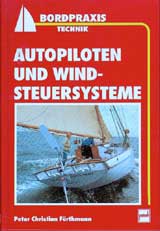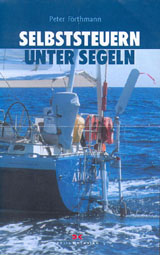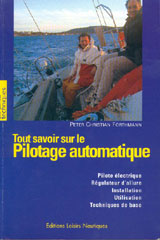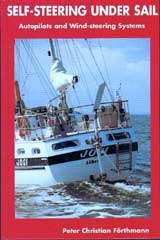 |
AUTOPILOTEN UND WINDSTEUERSYSTEMEAutor: Peter Förthmann Pietsch Verlag Stuttgart |
|||||||
Régulateur d´Allurede Peter Förthmann |
Autopiloti e timoni a ventodi Peter Förthmann |
|||||||
Timones de viento contra pilotos automáticos:un tema sobre el que todavía se discute. Este manual práctico consigue claridad. En él se analizan las técnicas de todos los sistemas de timón de viento existentes en el mercado. También se describe qué sistemas son adecuados, en función de su tamaño y su tipo de construcción, para qué embarcaciones, cómo es su funcionamiento y cuáles son sus ventajas y sus desventajas. ¿Qué sistemas son adecuados para cruising y racing? ¿Dónde están sus limitaciones bajo condiciones de oleaje y respecto al consumo de energía? |
||||||||
| ¿Por qué es tan importante el asiento de las velas para obtener un buen manejo automático? Sin hacer uso de complicados gráficos y de un ininteligible vocabulario profesional, el autor presenta sólidas y extensas informaciones así como numerosos consejos de fácil comprensión para la parte práctica del gobierno automático. Un sumario de la situación del mercado así como un listado de los fabricantes de pilotos de viento de casi todo el mundo completan el libro. | ||||||||
 |
SELBSTSTEUERN UNTER SEGELNAutor: Peter Förthmann Verlag Delius Klasing 2005 Praxisberatung vom Profi |
|||||||
 |
Tout savoir sur le Pilotage automatiquede Peter Förthmann Edition 2000 Pilote électrique |
|||||||
 |
SELFSTEERING UNDER SAILAuthor: Peter Förthmann El libro vuelve a estar a la venta desde diciembre del 2000 a través de
|
|||||||
Jimmy Cornell´s Foreword of the book:"For some strange reason, most cruising people profoundly dislike steering by hand. The prospect of spending hour after hour at the helmused to deter most people from long distance cruising. This is undoubtedly the main reason why, until relatively recently, the number of sailing boats venturing far afieldwas very small indeed. However, all that changed with the advent of automatic pilots specifically built for yachts plus the development of efficient wind operated self-steering devices. Suddenly, the chore of hand-steering was a thing of the past and long ocean passages could be a pleasure – even on yachts with the smallest of crews. Having made one circumnavigation of over 70.000 miles with an Aries and another of some 40.000 with a Hydrovane, I could not be accused of exaggerating if I state unreservedly that one of the most important pieces of equipment on any cruising yacht is a wind-operated self-steering gear. Unfortunately, and surprisingly, this view is not shared by many Cruising sailors. This is primarily because most of us have grown up with technology around us, we tend to take the push-button mentality with us to sea. Steering a given course is easy to achieve by setting a compass course and pushing a button on the autopilot, and, nowadays, this is what most sailors perfer to do. It is usually on the first morning with flat batteries that the love-affair with their favourite toy comes to an aprupt end. Having been forced to listen to countless heart-rendering stories on this very theme at the end of the ARC or similar trans-ocean rally, I managed to persuade Peter Förthmann to come to Las Palmas before the start of the ARC to talk to our participants about the pros and cons of self-steering. His talks and workshops became an instant success, not only becausde he knows this subject better than anyone else in the world, but also because he always speaks generically about both wind-operated self-steering gears and electronic autopilots. He never tried to sell his own products and, in this way, enjoyed the interest and confidence of his audience. I am therefore pleased, not only that he took my advice to write this long-overdue book, but also that he managed to do it so fairly and objectively by giving all his competitors an equal opportunity to make their products known. Alle existing systems are described in the following pages, allowing the reader to make up his own mind. Many sailors agree that Peter´s Windpilot is currently the best gear available. Being both the inventor and manufacturer of this ingenious device, Peter has indeed shown that his name should stand alongside those of his great precursors: Blondie Hasler, Marcel Gianoli, Nick Franklin. This book confirms Peter Förthmann´s standing as the world authority on wind-operated self-steering gears." |
George Day in BLUE WATER SAILING:"It's true: Big things come in small packages. Peter Christian Förthmann's unassuming little book on autopilots and wind-steering systems is a masterful reference work - eloquently presented, logically organized, wonderfully illustrated and easy to use. Anybody doing groundwork on a self-steering scheme owes it to himself to consult this source. |
|||||||
Andrew Bray in YACHTING WORLD 5/98:"Peter Förthmann's book, already published in German, is due for publication in English, by Adlard Coles, on 31 Luly. |
||||||||
OCEAN NAVIGATOR 12/98:"Because of the seemingly mystical reputation of these self-steering gadgets, a book dedicated entirely to their use and oerformance is well received. Choosing to purchase a windvane or autopilot is a big step - like committing yourself to something grand - because it imolies that the boat will soon be traveling long distances in one direction - in other words, crossing oceans. |
||||||||
El libro - una cronología¡Jimmy Cornell dio el impulso! Tras muchas conferencias en el marco de seminarios sobre el tema SELFSTEERING UNDER SAIL, que Peter Förthmann dio en Inglaterra y antes de la ARC en Las Palmas / Gran Canaria, fue Jimmy Cornell quien dio la idea de publicar un libro con el mismo título. Hasta la fecha no había literatura especializada sobre este tema, y el hambre de información de los navegadores era considerable. Peter Förthmann necesitó dos años para compilar y concentrar material sobre la extensa temática de los pilotos automáticos y los pilotos de viento. El libro fue publicado en otoño del 1998 por ADLARD COLES NAUTICAL / LONDON en cooperación con INTERNATIONAL MARINE / MAINE. En pocas semanas se vendió una gran parte de la edición. En USA, el libro apareció entre otros en las listas de Barnes & Nobles. Enero 1999 Octubre 1999 Octubre 2000 Este es el protocolo de una disputa sobre el capítulo "Power generator / autopilot hybrid", en el que se describe un sistema llamado Windhunter que se comercializó primero en Inglaterra, desde hace unos 10 años, y más tarde en USA. Durante el proceso quedaron claros los siguientes hechos: Un "reportaje test", publicado en YACHTING WORLD en abril del 1995 fue redactado por el presidente de Windhunter Sackville Currie - en la versión "Reprint" de este "reportaje test" así como en la página website, no se mencionaba el nombre del autor. En base a una orden del juez, el demandante fue obligado
El sistema Windhunter fue constantemente modificado, el manual de instrucciones apareció en aprox. 58 versiones distintas. La última versión del sistema de abril del 2000 contenía detalles que el demandado describió en el libro como útiles. "Self-Steering Under Sail"vuelve a estar a la venta desde diciembre del 2000. |
||||||||
DIE YACHT Nr 4 / 2001PROCESO GANADO Peter Foerthmann, propietario de la empresa Windpilot en Hamburgo, escribió en 1996 un libro especializado sobre pilotos automáticos y sistemas de gobierno de viento (Pietsch Verlag). La edición inglesa de 1988 corrió a cargo de la editorial Adlard Coles Nautical en Londres. Entre los sistemas que se añadieron para el mercado inglés figuraba también el sistema Windhunter. Este sistema híbrido generador/piloto automático fue desarrollado a inicios de los años 90 y se ganó cierto nombre gracias a un positivo artículo en YACHTING WORLD en 1995. Junto a su función como piloto automático, éste podía utilizarse también para la producción de corriente eléctrica. Quejas masivas de los compradores respecto a los constantes cambios y desarrollos así como la falta de calidad hicieron que Foerthmann escribiera un par de notas críticas acerca de este sistema, que por lo que parecía todavía no había sido muy madurado. El propietario de la empresa Richard Curran aprovechó estos comentarios para presentar una demanda por omisión y por daños y perjuicios. Éste acusó a su competidor Foerthmann, de querer barrerlo del mercado por ser su competencia. Mientras que la editorial Adlard Coles Nautical llegó después de un año a un costoso acuerdo y retiró el libro del mercado, Foerthmann siguió sólo con el proceso, a sabiendas de la multitud de compradores insatisfechos, que acabó con una victoria: los jueces condenaron al adversario Curran, a pagar todos los gastos de ambos partidos y a devolver directamente al autor el dinero que le había pagado la editorial por daños y perjuicios. Entretanto, Windhunter ha sido retirado del mercado. |
||||||||
